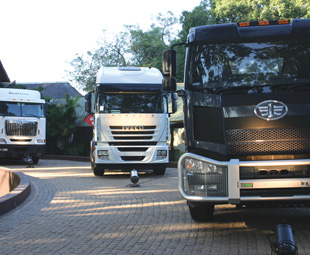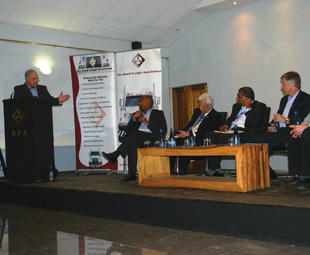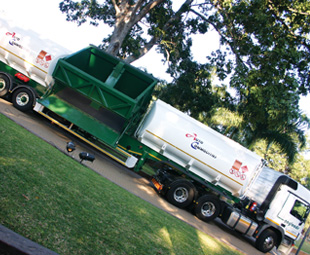Bigger, faster, stronger, smarter

Attracting some of the country’s top dignitaries, academic minds, business people and transport operators, this year’s Road Freight Association (RFA) Convention put the focus on “smarter trucking”. GAVIN MYERS went along too, to see just how smart our industry can become
It was perhaps fitting that the 2013 instalment of the annual RFA convention was hosted in the quiet town of Phalaborwa, Limpopo, at the Hans Merensky Hotel and Spa. Limpopo you see – much like many of the provinces in South Africa – suffers from some exceptionally beaten, worn, potholed, and simply bad, roads. The local municipalities don’t have the funds available to properly fix them.
Delegates who drove to Phalaborwa can attest to the sections of road in dire need of repair – made worse by the number of trucks that have no other choice but to use them each day, to reach the many small towns and many more farms scattered around the province.
 Indeed, one of the three key panel discussions (and perhaps the most contentious given the ongoing e-tolls debacle) centred on infrastructure funding. Together with discussions on fuel supply and smart technologies, we explore these topical, spirited debates individually throughout these report-back pages.
Indeed, one of the three key panel discussions (and perhaps the most contentious given the ongoing e-tolls debacle) centred on infrastructure funding. Together with discussions on fuel supply and smart technologies, we explore these topical, spirited debates individually throughout these report-back pages.
Perhaps the biggest news at this year’s conference was the attendance of South Africa’s Deputy President, Kgalema Motlanthe, on the first day. He was joined by the Deputy Minister of Transport, Sindiswe Chinkunga; the Acting Premier of Limpopo, Ntate Dickson Masemola; and the Mayor of Phalaborwa, Anna Sono.
The presence of such a high-level delegation was deemed a great step in pursuit of getting government and the industry to work hand-in-hand. “The RFA has always maintained that a strong relationship with government is vital,” says Sharmini Naidoo, CEO of the RFA. “We believe it’s essential that government engages with the transport industry to create the best transport policy possible for the county.”
In his opening address, Motlanthe acknowledged the importance of the RFA and the industry as an economic player. “The World Bank Logistics Index suggests that low- and middle-income economies could boost global trade by 15 percent just by improving logistics performance,” he said, adding that South Africa needs a road freight industry that “is growing in leaps and bounds to meet our developmental needs”.
Despite these sentiments, much of Motlanthe’s address hinged on the topic of rail. Stating that integrated national planning is essential to the success of government’s intention to boost growth through sustainable infrastructure development, Motlanthe noted that the biggest challenge to the South African freight logistics system is the ineffective road-rail split – with road dominating the industry.
“The division of cargo between road and rail comprised a split of 88,8 percent and 11,2 percent in 2010,” he said. “Ideally, long-haul cargo, such as coal and iron-ore, should be transported exclusively on rail.
“Moving freight from road to rail is a big strategic imperative,” he continued. “The key [strategic] element that should be considered is intermodality – the ability to shift between road and rail as quickly and efficiently as possible.
 “More inland port terminals, such as City Deep, in Johannesburg, are needed. Systems need to be put in place to ensure minimal delays when moving cargo from trains to road trucks. To this effect, the Department of Transport [DoT] is doing feasibility studies on intermodal facilities along the N3 Durban-Free State-Gauteng Corridor; forming part of the Strategic Infrastructure Projects,” noted Motlanthe.
“More inland port terminals, such as City Deep, in Johannesburg, are needed. Systems need to be put in place to ensure minimal delays when moving cargo from trains to road trucks. To this effect, the Department of Transport [DoT] is doing feasibility studies on intermodal facilities along the N3 Durban-Free State-Gauteng Corridor; forming part of the Strategic Infrastructure Projects,” noted Motlanthe.
Encouragingly, Motlanthe also expressed great concern at the stifling shortage of technical and transport engineering skills in the country. “The absence of real-life data continues to be a challenge, although the Council for Scientific and Industrial Research (CSIR) goes to great lengths to collate freight logistics information for its annual State of Logistics Survey, even though the information is usually a year late,” he said.
“The DoT is in the process of appointing a service provider to assist with the Review of the National Freight Logistics Strategy of 2005. This is an attempt to model and/or remodel the freight logistics industry in the country,” Motlanthe noted.
In closing, Motlanthe commended and congratulated the industry for its approach to tackling HIV/Aids and other ailments, while significantly reducing the stigma and discrimination that form barriers to care. “It is also commendable that this initiative has also been extended to the communities around where the services have been established, thus giving expression to your commitment, not only to those in your employ, but anyone else who visits your clinics seeking care,” he said, encouraging other industry sectors to take a leaf from the road freight industry’s book.
Infrastructure funding
During the panel discussion on infrastructure funding, entitled More Taxes, More Tariffs or Privatisation (facilitated by media personality Jeremy Maggs), one thing became clear – the South African economy will stop growing if we don’t spend on infrastructure. But a difficulty is the fact that South Africa is a very geographically-dispersed country.
 Therefore, says Irvan Naidoo, GM of strategy and business modelling at Transnet: “The transport intensity of our economy is higher than competing economies. We’re already starting off with a big disadvantage from a cost perspective.”
Therefore, says Irvan Naidoo, GM of strategy and business modelling at Transnet: “The transport intensity of our economy is higher than competing economies. We’re already starting off with a big disadvantage from a cost perspective.”
Mike Schűssler, director: Economists.co.za, adds: “Roughly R150 billion has to be spent on the roads to get them up to scratch, and the state is unlikely to be able to do it all itself.”
After all, South Africa’s road network stretches over 600 000 km; so wise spending is needed. “Most of the roads are past their lifespan and the South African National Roads Agency (Sanral) manages only about three percent of the network,” says Ravi Naidoo, CEO: Infrastructure and Development Advisory Practice. “Once you know which roads are needed, you then have to decide which get funding and from where.”
Nasir Alli, CEO: Sanral, provides some perspective: “Sanral looks after a strategic road network of about 20 000 km from a primary network of about 35 000 km. This carries 70 to 75 percent of surface freight.”
That is the majority of freight carried by a very small proportion of road. So what is to be done? A big reality currently facing the local transport and logistics sector is the re-emergence of rail and the push for an intermodal transport scenario.
Notes Irvan Naidoo: “Intermodal solutions can bring transport costs down. In five years time rail will be able to satisfy existing market demand and we’ll then start looking at new demand. But discussions need to start on where the intermodal terminals will be and how we’re going to invest in them.”
Naturally, this raises fears of the effect this will have on South Africa’s long-haul trucking business. But, counters Ravi Naidoo, there is nothing stopping the RFA becoming part of the consortium to own some of the incoming rail infrastructure.
However, spending money on infrastructure is one thing, where the money comes from and how well it’s spent are other issues that need to be addressed. “There are various ways to fund infrastructure,” says Irvan Naidoo, “but you will never have enough money to fund all your requirements. It depends on what makes sense in the context and finding the right mix.”
 This mix, says Dennis Dykes, chief economist: Nedbank, is completely wrong. “The public sector is at its limit of financing and does not have space to move going forward, and the private sector does not have enough to do with infrastructure, yet it brings expertise and financing to the table.” He notes: “There’s a severe lack of conversation with the private sector. There’s almost an attitude of ‘the state knows best’.”
This mix, says Dennis Dykes, chief economist: Nedbank, is completely wrong. “The public sector is at its limit of financing and does not have space to move going forward, and the private sector does not have enough to do with infrastructure, yet it brings expertise and financing to the table.” He notes: “There’s a severe lack of conversation with the private sector. There’s almost an attitude of ‘the state knows best’.”
Alli adds: “There is a huge mistrust between the government and the private sector. The RFA has a major role to play in overcoming that, but somebody has to pay for what we want and we are not putting sufficient weighting on what funding will come from where.”
“For a decade we haven’t been making investments in infrastructure, including maintenance,” says Ravi Naidoo. “For every rand you think you’re saving, you’re generating six rand in costs down the line.”
Schűssler concludes: “It’s now become extra, extra spending that we didn’t plan for. No country has a perfect balance, but spending on infrastructure has the biggest correlation with employment growth, and those jobs last.”
Smart technologies in trucking
Smart Trucks, or Performance Based Standards (PBS), was originally started in America during the 1970s. Discussion facilitator Paul Nordengen, research group leader: network asset management systems: CSIR, has been a chief advocate for the concept locally since 2004. It aims to improve the overall performance of the South African extra-heavy fleet.
How? By reducing vehicle trips; having fewer trucks on the road; improving the dynamic stability of trucks; improving transport productivity and reducing road wear per tonne kilometre.
Says Peter Lyne, professor at the University of KwaZulu-Natal: “Current regulation is prescriptive and specifies parameters to be adhered to. PBS means we specify the performance we’d like from the particular vehicle and design it specifically for the task.”
It is important to differentiate PBS from the similar Road Traffic Management System (RTMS), a voluntary self-regulation project in which around 3 500 trucks currently participate. A fleet must first be RTMS accredited to participate in PBS.
 Sixty smart trucks are currently in operation with 30 more in the design and approval phases. The demonstration project has covered 20 million kilometres so far. “We are aiming at 100 million kilometres and want smart trucks transporting different commodities in all provinces, so all authorities can experience the benefits,” says Nordengen.
Sixty smart trucks are currently in operation with 30 more in the design and approval phases. The demonstration project has covered 20 million kilometres so far. “We are aiming at 100 million kilometres and want smart trucks transporting different commodities in all provinces, so all authorities can experience the benefits,” says Nordengen.
And what benefits there are. “It’s an eye-opener – the prescriptive ways we’ve been doing things over the last 50 or 60 years still apply and are not that great,” says Adrian van Tonder, senior manager, business development: Barloworld Logistics and chair of the RTMS steering committee.
“Productivity and emissions need to be sorted out now with current technology, and dramatic savings are possible. Safety improves. Road wear is dramatically reduced. All of a sudden this becomes a corporate responsibility,” he continues enthusiastically.
Eric Aspeling, general manager logistics and fibre supply: Sappi, puts it into hard figures: “We’ve experienced a 20 percent improvement in load capacity, equalling a 12 percent cost improvement, after permit and design and purchase costs. Fuel consumption is improved by about 17 percent and, moving 700 000 tonnes per annum, we’ve reduced carbon emissions by 1 280 tonnes per annum.”
Gert Brits, general manager, mining services: Unitrans, concurs, “Our road trains have gained 16 percent in payload.”
Says Brian Hunt, MD Timber Logistics Services: “We’ve been operating for over four years and our accident rate has dropped by 50 percent with no disabling injuries. Our drivers are happier and performing better because they’re earning more and being well looked after.”
Despite these results, getting government’s attention hasn’t been easy. One province that has taken the desired notice is KwaZulu-Natal. Chris Stretch, senior manager, freight transport: KZN Department of Transport, gives an indication why: “It’s seldom there’s a project all parties benefit from; it helps consignors and consignees, the public and government. In KZN alone we’ve already saved over a million litres of fuel in one year.”
Nordengen sums it up perfectly: “By following PBS you pick up weaknesses in a vehicle’s design and rectify them.” And what better way is there to begin trucking smarter?
Fuel supply
Facilitated by Stuart Rayner, Naamsa Fuel and Emissions Technical Committee chair, the Fuel Supply panel discussion raised interesting and controversial points, based around the Clean Fuels 2 Programme.
Legislated for introduction in July 2017, it will involve reducing diesel sulphur levels to 10 ppm, which should correspond with the introduction of Euro-5 vehicles. Government has allocated around R49 billion for the programme.
Talk surrounding the programme raised some concerns, chiefly around South Africa’s current Euro-2 and -3 rated truck parc. Says Christo Kleynhans, product manager Mercedes-Benz South Africa: “In a Euro-3 engine fuel consumption will remain the same, with less particles getting in the oil, increasing engine life.”
Emissions caused by further refinement of the fuel, was also raised. “Energy consumption will rise 10 to 15 percent,” notes Dave Wright, director and special advisor to the MD and CEO: Engen. “In perspective, local crude oil refineries emit three million tonnes of CO2 a year, Eskom 220 million and Secunda 72 million.”
 Allied to cleaner fuels is the option of biofuels, where a five percent blend has been mooted. The panellists, however, weren’t convinced it’s viable for South Africa. “The feedstock comes from plant oil and we’d be diverting what we are producing away from food stock,” says Wright.
Allied to cleaner fuels is the option of biofuels, where a five percent blend has been mooted. The panellists, however, weren’t convinced it’s viable for South Africa. “The feedstock comes from plant oil and we’d be diverting what we are producing away from food stock,” says Wright.
Raymond Abraham, commercial technical manager: Shell, details the scale: “Current consumption of diesel is about 10 billion litres, five percent means 500 million litres …” Adds Wright: “The Bioethanol (for petrol) plantations currently mooted could produce 100 000 litres per annum; in that context, there’s a long way to go.”
Wright further dismisses the idea that oil supply is under threat: “Shale gas is allowing the United States to go from being a net oil importer to a net oil exporter. Forecasts show that, in the transportation game, hydrocarbons are going to be a mainstay through to 2050.”
The topic of biofuels naturally progressed to other aftermarket additives, none of which are approved in the current SANS spec.
“Additives used by fuel manufactures are researched, developed and tested to ensure the correct types are selected and give the promised benefits without causing engine damage,” says Abraham. “Aftermarket additives can offset this balance and stability. We invest $1,3 billion in R&D in some of these technologies.”
Kleynhans agrees, “Currently, 50 percent of Daimler’s patents are to do with reducing fuel consumption … Additives are typically tested for 20 or 30 000 kilometres – not nearly enough to show accurate results.”
Gerhard Marais, product group manager, logistics services: Rotran, proposed going back to basics as the best immediate solution – reducing the amount of fuel used to reduce emissions. “Operators should ask what they can do better. Go back to basics – ensure proper maintenance; that tyres match and are correctly inflated; that load distribution is correct; that tarps are not flapping around; invest in driver training; make sure the diesel delivered is correct; fight the pilferage of diesel; transport more with less travelling and empty loads,” he says.
“That is where we have to start together, instead of everybody trying to do their own thing,” he concludes.

Published by
Focus on Transport
focusmagsa




